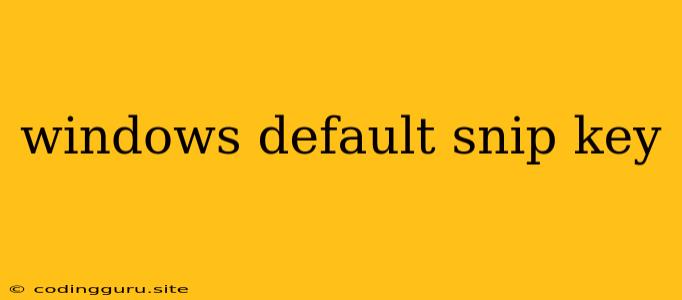Taking Screenshots on Windows: Mastering the Default Snipping Tool
Windows offers a built-in tool for capturing screenshots called the Snipping Tool. It's a simple yet powerful application that lets you take different types of screen captures, from simple rectangular selections to full-screen grabs. But how do you use it effectively? Let's explore!
The Power of the Snipping Tool: A Quick Overview
The Snipping Tool is accessible through the Windows search bar. Once you launch it, you'll find a user-friendly interface with various options for capturing your screen.
Understanding the Snipping Modes:
- Free-form Snip: This mode lets you draw a freehand shape around the area you want to capture. This is great for capturing irregularly shaped elements.
- Rectangular Snip: The most common and straightforward mode. You can select a rectangular area of your screen to capture.
- Window Snip: Capture a specific window, including its title bar and borders.
- Full-screen Snip: This mode takes a screenshot of your entire desktop, perfect for capturing presentations or system information.
The Classic Way: Using the Snipping Tool Shortcut
While you can access the Snipping Tool through the Windows search bar, you can also use a keyboard shortcut for faster access:
- Press the Windows key + Shift + S.
- This will activate the Snipping Tool and dim your screen.
- Select the desired snipping mode (free-form, rectangular, window, or full-screen) by clicking on it.
- Use your mouse to select the area you want to capture.
- The captured image will be automatically copied to your clipboard.
Save Your Snippets:
- You can paste the image into any application that accepts images (like Microsoft Word, Paint, or even a web browser).
- If you want to save the image directly, right-click on the captured image, and select "Save as". You can then choose the desired location and file format.
Beyond the Basics: Customizing the Snipping Tool
While the basic functionality of the Snipping Tool is quite intuitive, there are a few advanced features worth exploring:
- Delay Snip: Need a few seconds to prepare before you capture? The Snipping Tool allows you to set a delay before taking the screenshot. This is useful for capturing menus or other dynamic elements.
- Pen and Highlighter: After taking a screenshot, you can draw on it using the Snipping Tool's pen and highlighter tools. This allows you to annotate screenshots and highlight specific areas.
- Open with: Choose the default application to open your captured image in. This can be any image editor or viewer you prefer.
Alternatives to the Snipping Tool:
For more advanced needs, several third-party applications offer richer functionality and features. Some popular options include:
- Lightshot: This is a powerful and free tool for capturing screenshots and sharing them online. It offers features like editing tools, uploading, and sharing options.
- Snagit: This is a more comprehensive solution for screen capture, offering advanced editing capabilities, recording options, and more.
Conclusion:
The Snipping Tool is a versatile tool for taking screenshots on Windows. It's simple to use, free, and offers enough features for most users. However, for advanced needs, exploring third-party applications might be more suitable. With the Snipping Tool at your disposal, capturing moments on your screen is a breeze!
